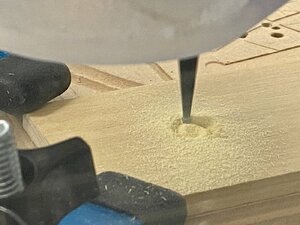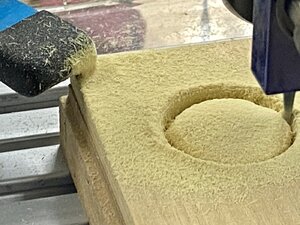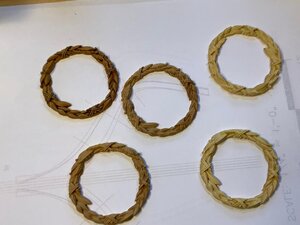-

Win a Free Custom Engraved Brass Coin!!!
As a way to introduce our brass coins to the community, we will raffle off a free coin during the month of August. Follow link ABOVE for instructions for entering.
-

PRE-ORDER SHIPS IN SCALE TODAY!
The beloved Ships in Scale Magazine is back and charting a new course for 2026!
Discover new skills, new techniques, and new inspirations in every issue.
NOTE THAT OUR FIRST ISSUE WILL BE JAN/FEB 2026
You are using an out of date browser. It may not display this or other websites correctly.
You should upgrade or use an alternative browser.
You should upgrade or use an alternative browser.
One of the challenges with CNC machining is the cutting of perfect inside 90-degree corners. Since the CNC tool is round, the operation of cutting an inside 90 degree angle will always result in a curve that equals the radius of the bit. This can be clearly seen in the photo below. The notches on the left are original CNC cut with rounded corners, while the notches on the right have been squared up manually using knife/files.
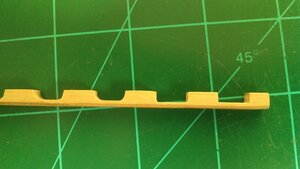
Several months ago, I discovered a technique used by CNC furniture makers to overcome this problem. It is called a Dog-Bone Fillet. It allows for perfectly square fitment of parts of this nature without the need to manually square up the notches. Dog-Bone Fillet functions are available on most high-end CAD software programs today.
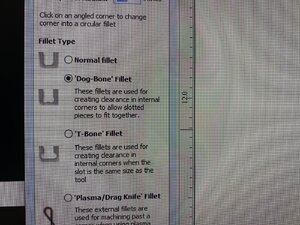
Below is a picture of what I am describing. I have greatly exaggerated the Dog-Bone Fillet to give you an idea of this technique. Once cut this way, the parts will match up perfectly square with the dog-bone hidden after assembly. I have never seen this technique used in any kit I have ever purchased. Have you??
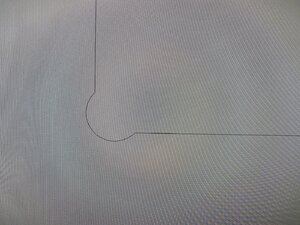

Several months ago, I discovered a technique used by CNC furniture makers to overcome this problem. It is called a Dog-Bone Fillet. It allows for perfectly square fitment of parts of this nature without the need to manually square up the notches. Dog-Bone Fillet functions are available on most high-end CAD software programs today.

Below is a picture of what I am describing. I have greatly exaggerated the Dog-Bone Fillet to give you an idea of this technique. Once cut this way, the parts will match up perfectly square with the dog-bone hidden after assembly. I have never seen this technique used in any kit I have ever purchased. Have you??

WOW!! How can I get you to make one of these for my Jeff Staudt Battle Station project?? One like this did not come with the kit.Here is a CNC carved wreath. I believe from Yellowheart.
View attachment 161297
View attachment 161296
View attachment 161295
View attachment 161298
View attachment 161299
stunning work - just incredible.
Here are three of my old You Tube demo videos for your viewing pleasure:
CNC cutting of shot racks from boxwood:
Quick laser demo:
Demo on the use of 3D tabs on CNC parts. My tabs are small triangles that allow the part to be easily removed from the billet:
CNC cutting of shot racks from boxwood:
Quick laser demo:
Demo on the use of 3D tabs on CNC parts. My tabs are small triangles that allow the part to be easily removed from the billet:
Yes, my friend. I do have a wreath for you. Ready to mail, FOR FREE. Please check your PM.WOW!! How can I get you to make one of these for my Jeff Staudt Battle Station project?? One like this did not come with the kit.
If you think those wreaths look good in photos, wait until you see them in person!!
I have a couple of "spares". I may do a little mini-battle station with one gun port to utilize the wreath!
Once the CNC job has completed there is a pile of sawdust so fine it is almost like a powder
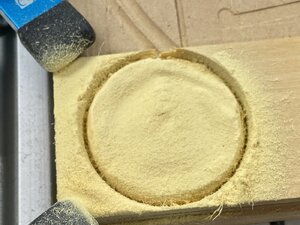
Vacuum away the dust and a nice 3D carving of a 1:32 gunport wreath is revealed. This fits the Jeff Staudt Battle Station plans.
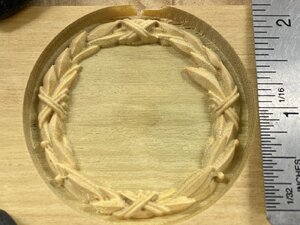
The CNC machining is so precise the part remains attached to the billet via a paper thin sheet of wood that can easily be trimmed away with a knife. This provides a very safe method for shipment.... world-wide.
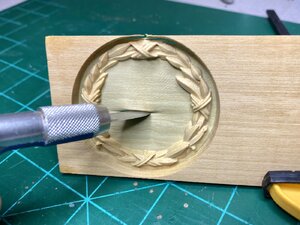

Vacuum away the dust and a nice 3D carving of a 1:32 gunport wreath is revealed. This fits the Jeff Staudt Battle Station plans.

The CNC machining is so precise the part remains attached to the billet via a paper thin sheet of wood that can easily be trimmed away with a knife. This provides a very safe method for shipment.... world-wide.

Great work, Mike!
Wow! Impressing.
Hello Mike- Incredible results! Is Osage Orange better suited than other woods for CNC machining. Would it work just as well with Swiss Pear or more dense woods like Castello Boxwood or Madagascar Ebony (the world's blackest/densest ebony)? Also, I just received an email from woodpeck.com- they have quite a few live edge slabs of Osage Orange!
Last edited:
We only used Osage on the wreath primarily for it's color. Over time it will actually darken to an almost brown color. For CNC machining we want to use the very finest grain wood possible to get the best results. Pear and Boxwood are my most common choices. I have ebony and can machine it but it tends to be a bit messy. I have also laser cut ebony with no problems.Hello Mike- Incredible results! Is Osage Orange better suited than other woods for CNC machining. Would it work just as well with Swiss Pear or more dense woods like Castello Boxwood or Madagascar Ebony (the world's blackest/densest ebony)?
Dave Stevens and others are more of the wood expert but so far I have found pear and boxwood the best for CNC machining. But that does not stop me from trying anything. LOL.
BTW Robert - that is your wreath. The Admiral should get it out in the mail today. I will PM you the tracking number when she gives it to me.
LOL.... I forgot I did so many!! There were a bunch of prototypes before those as well..You sent me wreaths made of osage orange, yellowheart and boxwood.
The darker wreaths are osage orange. You can see the darkening in the two years since they were milled!






